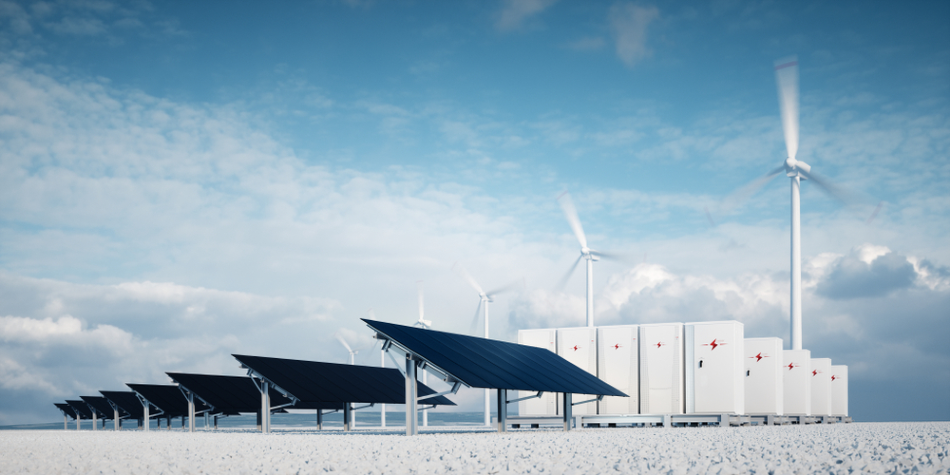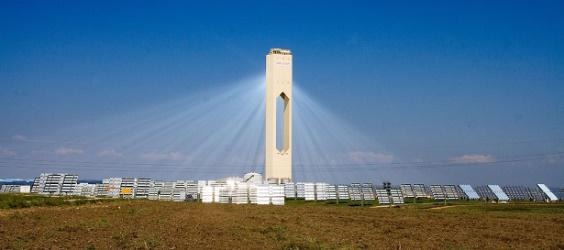
Image Credit: petrmalinak/Shutterstock.com
Engineers from Sandia National Laboratories have developed a falling particle receiver at the National Solar Thermal Test Facility. The technology is to be eventually used in solar power towers for electricity generation.
The receiver works by dropping small sand-like ceramic particles through a beam of concentrated sunlight to heat them up. These particles then act as a heat storage medium for electricity production using a steam turbine. They are to replace molten salt as the energy storage medium currently used in solar power towers. The small size of the ceramic particles, combined with its ability to store heat energy at a much higher temperature than molten salt, increases electrical generation efficiency.
These particles, according to Sandia, can store heat at a higher temperature than is possible with molten salt, which is the medium used right now in solar power towers for the thermal energy storage system, without breaking down chemically.
Having an energy storage system is very useful because it allows for electricity to be produced when the sun's energy is not available, such as when it is cloudy outside or at night. Heat energy from concentrated sunlight is only available when the sun is shining. The same principle applies to a magnifying glass. Unless the sun is shining you cannot focus the sunlight to a hot point.
The picture below shows a power tower:

Image Credit: afloresm/Wikimedia
How a Solar Power Tower Works
A conventional solar power tower works by the following principle:
Using many heliostats (mirrors), the sun is focused onto a central tower (receiver) using tracking mechanisms that adjust the orientation of the mirrors to focus the sunlight onto the central tower. This concentrated sunlight can be directly used to heat water to generate high-pressure steam. High-pressure steam then runs a turbine to generate electricity.
In more advanced designs, such as Solar Two, heat from the power tower heats up molten salt to 565 °C. The salt is then stored in large insulated tanks. Note that insulating the storage tanks is important because it minimizes the heat loss from the molten salt inside the tanks to the surrounding environment. A heat loss like this is an efficiency loss, which causes a decrease in electrical power output since energy is leaving the system and is not being utilized.
When power is requested, the heated molten salt is circulated through pipes that exchange heat with a steam turbine to produce electricity. After exchanging heat with the steam turbine the (cooler) molten salt goes into a “cold” storage tank at a temperature of 290 °C.
The molten salt remains in the cold storage tanks until it is circulated back out and heated up again in the power tower. The cycle is then repeated.
The molten salt is substituted by the particles serving the same function, which is to heat water to produce high-pressure steam for electricity production. The schematic below illustrates the basic process used to heat the ceramic particles.
How the Ceramic Particles Increase Efficiency
According to Sandia, the operating temperature of the particles can exceed 1,000 °C. This is more than 400 degrees higher than the operating temperature of molten salt systems. This much higher temperature means more stored energy and lower storage costs, since less energy storage material is needed to hold a certain amount of energy. In this case, the energy storage material is the ceramic particles.
A higher temperature storage material also increases thermodynamic efficiency, which means more electricity can be produced in the steam turbines. This is based on the thermodynamic principle of Carnot efficiency.
The engineers at Sandia stress the importance of using these small, sand-like ceramic particles, rather than molten salt, because they can store more energy due to their ability to reach higher temperatures without breaking down chemically.
It is desirable to use small particles because they heat up quickly when exposed to the concentrated sunlight. When needed, heat is gained back from them quickly. Small particle size allows for quick and efficient heat transfer to and from the particles.
When the particles transfer their heat to water for steam production, they do so using a heat exchanger. This heat exchanger enables heat to be transferred from the particles to the water. Due to their small size, the particles effectively "flow" through the heat exchanger and provide a large amount of contact area from which to conduct their heat to the water. This further improves heat transfer efficiency. As an analogy, imagine putting your hand in a pail full of hot rocks the size of pebbles versus a pail full of hot sand, with both at the same temperature. Which will give you the biggest burn? The pail with the hot sand, for the reason previously given.
How the Entire System Works
Below demonstrates in detail how the entire storage system works using the particles:
- Particles fall through the top receiver where they are exposed to concentrated sunlight through the aperture. This causes the particles to heat up.
- The heated particles fall into an insulated storage tank, where they accumulate. This tank is called the "hot storage tank".
- The heated particles are transferred from the hot storage tank into a heat exchanger where they transfer their heat to water. This water heats up to a high temperature and produces high-pressure steam, which is then used to drive a turbine generating electricity for use in the electrical grid.
- The particles, now cooler, fall into another storage tank called the "cold storage tank".
- The cooled particles are brought up via an elevator to the top receiver to heat up again. The cycle then repeats.
The idea behind the hot storage tank is that it can store enough heated particles to enable electricity production for when it is cloudy outside or during the night. There needs to be enough heated particles stored in the hot storage tank to last for long stretches of time.
The best time to accumulate heated particles in the storage tank is when there is minimal demand for electricity and the sun is shining. At this point, the supply of particles into the heat exchanger, from the hot storage tank, can be reduced or stopped, since electricity generation is not as important. This will allow the number of particles in the hot storage tank to be increased, creating a thermal energy "buffer", so that when the demand for electricity increases once more, and/or when it is night/cloudy, the heated particles can be fed into the heat exchanger to produce electricity.
Sources and Further Reading
Disclaimer: The views expressed here are those of the author expressed in their private capacity and do not necessarily represent the views of AZoM.com Limited T/A AZoNetwork the owner and operator of this website. This disclaimer forms part of the Terms and conditions of use of this website.